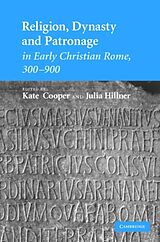Religion, Dynasty, and Patronage in Early Christian Rome, 300-900
Einband:
Fester Einband
EAN:
9780521876414
Untertitel:
Englisch
Autor:
Kate (University of Manchester) Hillner, J Cooper
Herausgeber:
Cambridge University Press
Anzahl Seiten:
344
Erscheinungsdatum:
09.08.2010
ISBN:
0521876419
Informationen zum Autor Kate Cooper is Senior Lecturer in Early Christianity and Director of the Centre for Late Antiquity at the University of Manchester. Julia Hillner is a British Academy Postdoctoral Fellow in the Department of Classics and Ancient History and the Centre for Late Antiquity at the University of Manchester. Klappentext Traces the central role played by aristocratic patronage in the transformation of the city of Rome at the end of antiquity. It moves away from privileging the administrative and institutional developments related to the rise of papal authority as the paramount theme in the city's post-classical history. Instead the focus shifts to the networks of reciprocity between patrons and their dependents. Using material culture and social theory to challenge traditional readings of the textual sources! the volume undermines the teleological picture of ecclesiastical sources such as the Liber Pontificalis! and presents the lay! clerical! and ascetic populations of the city of Rome at the end of antiquity as interacting in a fluid environment of alliance-building and status negotiation. By focusing on the city whose aristocracy is the best-documented of any ancient population! the volume makes an important contribution to understanding the role played by elites across the end of antiquity. Zusammenfassung Discusses the transformation of Rome in late antiquity and the early Middle Ages. While traditional studies have focused on the rise of the papacy in the transition from the ancient world to the Middle Ages! in this book the newly Christianised senatorial aristocracy is discussed. Inhaltsverzeichnis Introduction Kate Cooper and Julia Hillner; Part I. Icons of Authority: Pope and Emperor: 1. From Emperor to Pope? Ceremonial, space, and authority at Rome from Constantine to Gregory the Great Mark Humphries; 2. Memory and authority in sixth century Rome: the Liber Pontificalis and the Collectio Avellana Kate Blair-Dixon; Part II. Lay, Clerical, and Ascetic Contexts for the Roman GESTA MARTYRUM: 3. Domestic conversions: households and bishops in the late antique 'Papal legends' Kristina Sessa; 4. Agnes and Constantia: domesticity and cult patronage in the Passion of Agnes Hannah Jones; 5. 'A church in the house of the saints': property and power in the Passion of John and Paul Conrad Leyser; Part III. Religion, Dynasty, and Patronage: 6. Poverty, obligation, and inheritance: Roman heiresses and the varieties of senatorial Christianity in fifth-century Rome Kate Cooper; 7. Demetrias ancilla dei: Anicia Demetrias and the problem of the missing patron Anne Kurdock; 8. Families, patronage and the titular churches of Rome, c.300-c.600 Julia Hillner; 9. To be the neighbour of St Stephen: patronage, martyr cult, and Roman monasteries, c.600-c.900 Marios Costambeys and Conrad Leyser....
Klappentext
Traces the central role played by aristocratic patronage in the transformation of the city of Rome at the end of antiquity. It moves away from privileging the administrative and institutional developments related to the rise of papal authority as the paramount theme in the city’s post-classical history. Instead the focus shifts to the networks of reciprocity between patrons and their dependents. Using material culture and social theory to challenge traditional readings of the textual sources, the volume undermines the teleological picture of ecclesiastical sources such as the Liber Pontificalis, and presents the lay, clerical, and ascetic populations of the city of Rome at the end of antiquity as interacting in a fluid environment of alliance-building and status negotiation. By focusing on the city whose aristocracy is the best-documented of any ancient population, the volume makes an important contribution to understanding the role played by elites across the end of antiquity.
Zusammenfassung
Discusses the transformation of Rome in late antiquity and the early Middle Ages. While traditional studies have focused on the rise of the papacy in the transition from the ancient world to the Middle Ages, in this book the newly Christianised senatorial aristocracy is discussed.
Inhalt
Introduction Kate Cooper and Julia Hillner; Part I. Icons of Authority: Pope and Emperor: 1. From Emperor to Pope? Ceremonial, space, and authority at Rome from Constantine to Gregory the Great Mark Humphries; 2. Memory and authority in sixth century Rome: the Liber Pontificalis and the Collectio Avellana Kate Blair-Dixon; Part II. Lay, Clerical, and Ascetic Contexts for the Roman GESTA MARTYRUM: 3. Domestic conversions: households and bishops in the late antique 'Papal legends' Kristina Sessa; 4. Agnes and Constantia: domesticity and cult patronage in the Passion of Agnes Hannah Jones; 5. 'A church in the house of the saints': property and power in the Passion of John and Paul Conrad Leyser; Part III. Religion, Dynasty, and Patronage: 6. Poverty, obligation, and inheritance: Roman heiresses and the varieties of senatorial Christianity in fifth-century Rome Kate Cooper; 7. Demetrias ancilla dei: Anicia Demetrias and the problem of the missing patron Anne Kurdock; 8. Families, patronage and the titular churches of Rome, c.300-c.600 Julia Hillner; 9. To be the neighbour of St Stephen: patronage, martyr cult, and Roman monasteries, c.600-c.900 Marios Costambeys and Conrad Leyser.

Leider konnten wir für diesen Artikel keine Preise ermitteln ...
billigbuch.ch sucht jetzt für Sie die besten Angebote ...
Die aktuellen Verkaufspreise von 6 Onlineshops werden in Realtime abgefragt.
Sie können das gewünschte Produkt anschliessend direkt beim Anbieter Ihrer Wahl bestellen.
Loading...
Die aktuellen Verkaufspreise von 6 Onlineshops werden in Realtime abgefragt.
Sie können das gewünschte Produkt anschliessend direkt beim Anbieter Ihrer Wahl bestellen.
| # | Onlineshop | Preis CHF | Versand CHF | Total CHF | ||
|---|---|---|---|---|---|---|
| 1 | Seller | 0.00 | 0.00 | 0.00 |
